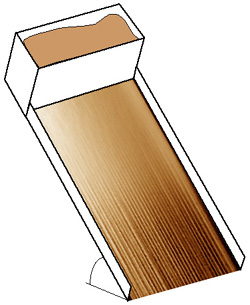Swirling Sand Mimics Liquid and Gas

Is it a liquid, a solid, or a gas? That question puzzles physicists studying the collective motion of small particles–such as sand–because granular materials can act in ways similar to all three states of matter. In a simple experiment presented in the 25 June PRL, researchers observed sand sliding down a rough slope and saw the first example of spontaneous vortices forming in granular matter. Their analysis reveals that sand can display characteristics of both a liquid and a gas simultaneously. The result may help geophysicists make better models and draws a crucial connection between liquid and gas behavior in granular systems.
Grainy motion exists everywhere in nature. Landslides, sandstorms, even the flow of your breakfast cereal into the bowl could be described using the granular flow equation–if such an equation existed. “We still haven’t discovered the law of granular flows,” says Yoel Forterre, a graduate student at the University Institute of Thermal and Industrial Systems (IUSTI) in Marseille, France. That’s because granules moving en masse baffle researchers by behaving like a liquid, a solid, or a gas, depending on the circumstances.
A mixture of liquid-like and gas-like motion appears to govern a new experiment by Forterre and Olivier Pouliquen, also of IUSTI. The set-up consists of a large hopper of sand placed above a rough inclined plane. When the hopper is opened, the sand flows rapidly down the plane like a liquid. When the incline of the plane is steep, a series of periodic ridges forms parallel to the direction of flow. Using a CCD camera, the team observed individual grains of sand slide from ridge tops into the troughs. As the surface particles slid down the ridges, submerged granules pushed their way to the top–a sign of churning vortices inside the flow. Vortices are common in fluids but this is the first time they’ve appeared spontaneously in granular flows, says Forterre.
To find the cause of the vortices, Forterre and Pouliquen measured the density of the thin layer of flowing sand by shining light through it. They found that the flow material rising to the peaks was less dense than that falling in the troughs, which led to an explanation for the vortices: As the sand flows down the rough slope, the roughness agitates the bottommost grains of sand, increasing their random motion, or “heating” them. As their “temperature” rises, their density decreases until it is less than that of the grains above them. The denser sand on top sinks while light sand on the bottom rises, creating swirling vortices akin to the convection rolls that are common in gases heated from below.
Further study of sand on an incline could help geologists understand landslides and mudflows–cases where rocks and dirt flow down rough surfaces. But Heinrich Jaeger of the University of Chicago thinks it might have even more fundamental implications. Jaeger says this is a rare case where both liquid- and gas-like properties (flow on an incline and convection) appear in the same system, and the experiments may help researchers learn how to apply the two sets of equations and work toward the ultimate laws that little grains obey.
–Geoff Brumfiel


